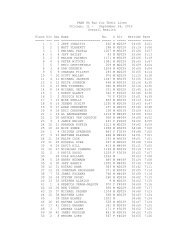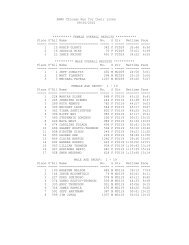Winter 2010 - PAWS Chicago
Winter 2010 - PAWS Chicago
Winter 2010 - PAWS Chicago
Create successful ePaper yourself
Turn your PDF publications into a flip-book with our unique Google optimized e-Paper software.
PET HEALTH & BEHAVIOR<br />
Rank order is established and maintained<br />
through a series of ritualized fights and posturing.<br />
Wolves prefer this to physical confrontations.<br />
Physical confrontations would<br />
only serve to weaken the pack. Rank order<br />
can shift constantly according to the needs<br />
of the pack at any given time. Rank order<br />
is only one of the many social traits used<br />
to keep the pack running smoothly. Wolves<br />
possess many ritualized behavior patterns<br />
that are recognized amongst other pack<br />
members to have a specific meaning.<br />
In her book, “Aggression In Dogs”,<br />
Brenda Aloff states that dogs also use ritualized<br />
behavior patterns to determine without<br />
resorting to violence, who gives in and<br />
who prevails in situations where conflict<br />
exists. Although developing our skills for<br />
understanding a dog’s language is a subject<br />
in itself, we need to understand how a dog<br />
interacts with members of it’s own species<br />
to understand how he is attempting to<br />
interact with us.<br />
By gaining an understanding of the complexities<br />
of canine behavior we can bypass<br />
the notion that every problem behavior we<br />
encounter with our dogs is due to the dog<br />
being either “dominant” or “submissive”.<br />
Dispelling this notion opened the door for<br />
a broader view of how we can relate to our<br />
dogs. Dog training that relies solely on the<br />
use of physical correction or the notion that<br />
a dog needs to be physically dominated is a<br />
thing of the past.<br />
The American Veterinary Society of<br />
Animal Behavior (AVSAB) warns against<br />
the use of “dominance” based training techniques<br />
explaining how they can damage the<br />
human-dog relationship. The AVSAB goes<br />
to great lengths to explain the difference<br />
between leadership and dominance stating<br />
that, “leadership is established when a<br />
pet owner can consistently set clear limits<br />
for behavior and effectively communicate<br />
the rules by immediately rewarding the<br />
correct behavior and preventing access to<br />
or removing rewards for undesirable behaviors<br />
before the undesirable behavior is<br />
reinforced.”<br />
Science based dog training methods,<br />
spearheaded by the work of Karen Pryor,<br />
are now being explored and widely used.<br />
Pryor used psychologist B. F. Skinner’s<br />
theory of operant conditioning to develop<br />
the clicker training method in which a<br />
small plastic noisemaker is used to mark a<br />
behavior that will earn a reward. An animal<br />
tends to repeat an action that has positive<br />
consequences. The results are amazing.<br />
Dogs learn with eagerness and gain a clear<br />
understanding of the task at hand, unclouded<br />
by the fear of making a mistake and<br />
physical punishment.<br />
Our relationships with our dogs continue<br />
to evolve. In our present day urban environment,<br />
dogs no longer perform tasks that<br />
are needed for our survival. Still they are an<br />
important part of our lives. We depend on<br />
them for companionship and unconditional<br />
loyalty and affection. They get us out every<br />
day for walks and work as our partners in<br />
agility class. They still function as playmates<br />
for our children and companions for the<br />
elderly. It’s a safe bet that man will always<br />
have a place in his home for the family dog.<br />
Joan Harris is a<br />
regular contributor<br />
to Angel Tales.<br />
She serves as<br />
Head Trainer at K9<br />
University.
















